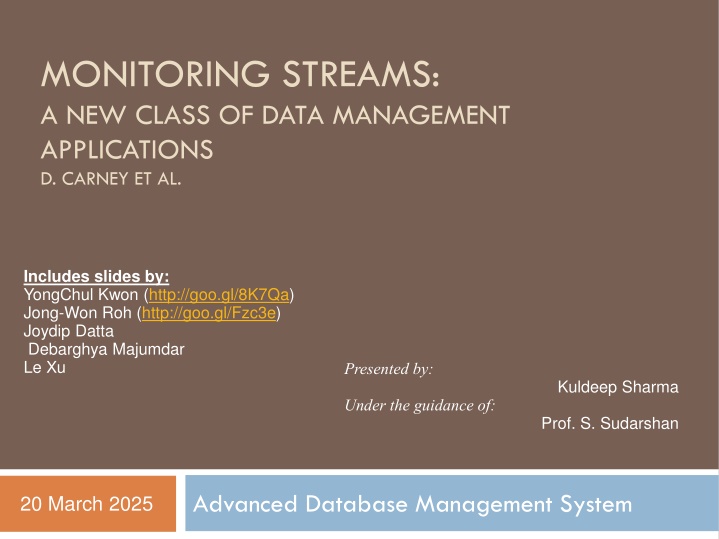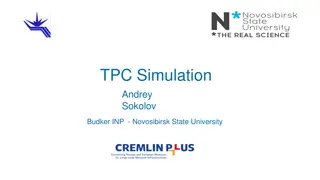
Monitoring Streams: A New Class of Data Management Applications
Explore the world of monitoring applications with a focus on continuous data streams, abnormal activity detection, and real-time alerts. Learn about the challenges faced by traditional DBMS and the innovative solutions like the Aurora system. Discover examples of monitoring applications in stock brokerage, military operations, and equipment tracking.
Download Presentation

Please find below an Image/Link to download the presentation.
The content on the website is provided AS IS for your information and personal use only. It may not be sold, licensed, or shared on other websites without obtaining consent from the author. If you encounter any issues during the download, it is possible that the publisher has removed the file from their server.
You are allowed to download the files provided on this website for personal or commercial use, subject to the condition that they are used lawfully. All files are the property of their respective owners.
The content on the website is provided AS IS for your information and personal use only. It may not be sold, licensed, or shared on other websites without obtaining consent from the author.
E N D
Presentation Transcript
MONITORING STREAMS: A NEW CLASS OF DATA MANAGEMENT APPLICATIONS D. CARNEY ET AL. Includes slides by: YongChul Kwon (http://goo.gl/8K7Qa) Jong-Won Roh (http://goo.gl/Fzc3e) Joydip Datta Debarghya Majumdar Le Xu Presented by: Kuldeep Sharma Under the guidance of: Prof. S. Sudarshan Advanced Database Management System 20 March 2025
Outline 2 Motivation Monitoring Applications Special needs of monitoring applications Aurora System and Query Model of Aurora Operators in Aurora Aurora System Architecture Conclusion
Monitoring Applications 3 Concept Monitor continuous data streams, detect abnormal activity, and alert users those situations Data Stream Continuous, Unbounded, Rapid, May contain missing, out of order values Occurs in a variety of modern applications
Examples of Monitoring Applications 4 Monitoring the ups and downs of various stock prices in a Stock Broker Firm Process streams of stock tickers from various sources Monitoring the health and location of soldiers in a warzone Process streams of data coming from sensors attached to the soldiers Some data items may be missing Alerts the control room in case of health hazards Monitor the location of borrowed equipments Process streams of data coming from RFID sensors Alerts when some items goes missing
Motivation Monitoring applications are difficult to implement in the traditional DBMS Traditional DBMS Needs of Monitoring applications One time query: Evaluated once on a fixed dataset Queries once registered continuously act on incoming flow of tuples (like a filter) Applications need some history of the data (time series data) Triggers are one of the central features. Must be scalable Real time service is required Stores only the current state of the data Triggers secondary features; often not scalable Does not require real time service Data items assumed to be accurate Data may be incomplete, lost, stale or intentionally dropped 5
Aurora 6 This paper describes a new prototype system, Aurora, which is designed to better support monitoring applications Stream data Continuous Queries Historical Data requirements Imprecise data Real-time requirement
Aurora Overall System Model 7 User application QoS spec Query spec Aurora System Historical Storage data flow (collection of stream) External data source Operator boxes Query spec 7/15 Application administrator
Example 8 Suppose, in a hospital, continuous stream of doctor s position, patient s health, position etc. is monitored Patients Nearby doctors who can work on a heart patient Filter (disease=heart) Join Doctors Join condition: (Patient.location doctor.location) <
Representation of Stream 9 Aurora stream tuple: (TS=ts, A1=v1, A2=v2 .. An=vn) TS (Timestamp) information is used for QoS calculation
Operators in Aurora 10 Filter: screens tuples based on input predicate Like select in usual DBMS Map is a generalized projection operator Union: merge two or more streams with common schema into a single output stream. Note: Operators like Join, however can not be calculated over unbounded streams Those operations are defined in windows over the input stream (described in next slide) 10
Concept of Windowing 11 Monitoring Systems often applies operations on a window Operations (e.g. Join) can not be applied over infinite length streams Window marks a finite length part of the stream Now we can apply operations on windows Window advancement Slide: perform rolling computations (e.g. max stock price in last one hour) Tumble: Consecutive windows has no tuple in common (e.g. hourly max stock price) Latch: Like tumble but may have internal state (e.g. Max stock price in life time)
Operations in Aurora (cntd.) 12 Aggregate: Applies aggregate function on windows over input stream Syntax: Aggregate(Function, Assuming order, Size s, Advance I, Timeout t) (S) Join: Binary join operation on windows of two input streams Syntax: Join(P, Size s)(S1,S2) Note: For now, we assume all tuples are ordered by timestamp
Aurora Query Model 14 Three types of queries Continuous queries: Continuously monitors input stream Views: Queries yet not connected to application endpoint Ad-hoc queries: On demand query; may access predefined history
Aurora Query Model (cntd.) 15 Continuous queries: Continuously monitors input stream QoS spec data input b1 b2 b3 app continuous query Connection point Picture Courtesy: Reference [2]
Connection Points 16 Supports dynamic modification to the network (say for ad-hoc queries) Stores historical data (App author specifies duration)
Aurora Query model: Views 17 QoS spec data input b1 b2 b3 app continuous query Connection point b4 QoS spec view b5 b6 Picture Courtesy: Reference [2]
Views 18 No app connected to the end point May still have QoS specs Applications can connect to the end any time Values may be propagated to the view lazily until some app connects Values may be materialized
Aurora Query model: Ad-hoc queries 19 QoS spec data input b1 b2 b3 app continuous query Connection point b4 QoS spec view b5 b6 ad-hoc query b7 b8 b9 app QoS spec Picture Courtesy: Reference [2]
Ad-hoc queries 20 Can be attached to a connection point at any time Gets all the historical data stored at the connection point Also access new data items coming in Acts as a continuous query until disconnected by the app
Aurora Optimization 21 Dynamic Continuous Query Optimization Ad-hoc query optimization
Continuous Query Optimization 22 The un-optimized network starts executing... optimizations are done on the go Statistics are gathered during execution Cost and Selectivity of a box The network is optimized at run time Can not pause the whole network and optimize Optimizers selects a sub-network, holds all incoming flow, flushes the items inside and then optimizes Output may see some hiccups only
Optimization 23 Courtesy: Slides by Yong Chul Kwon Aggregate Join Map Filter pull data Hold Union Continuous query Filter Hold Ad hoc query Filter BSort Map Static storage Aggregate Join
Continuous Query Optimization 24 Local tactics applied to the sub-network Inserting projections: Attributes not required are projected out at the earliest Combining Boxes: Boxes are pair-wise examined to see if they can be combined Combining reduces box execution overhead Normal relational query optimization can be applied on combined box Example: filter and map operator, two filters into one etc Re-ordering boxes: cntd to next slide 1. 2. 3.
Reordering Boxes Each Aurora box has cost and selectivity associated with them Suppose there are two boxes biand bj connected to each other. Let, C(bi) = cost of executing bi for one tuple S(bi) = selectivity of bi C(bj) = cost of executing bjfor one tuple S(bj) = selectivity of bj Case 1: Case 2: bi bj bj bi Overall Cost = C(bi) + C(bj) * S(bi) Overall Cost = C(bj) + C(bi) * S(bj) Whichever arrangement has smaller overall cost is preferred Iteratively reorder boxes until no more reorder is possible 25
Optimizing Ad-hoc queries 26 Two separate copies sub-networks for the ad-hoc query is created COPY#1: works on historical data COPY#2: works on current data COPY#1 is run first and utilizes the B-Tree structure of historical data for optimization Index look-up for filter, appropriate join algorithms COPY#2 is optimized as before
Aurora Runtime inputs outputs Storage Manager Router Q1 Q2 Scheduler Qm Buffer manager Data Stream Box Processors Output Catalog Persistent Store Q1 Q2 Load Shedder QoS Monitor Qn Picture Courtesy: Reference [2]
QoS Specification 28 Response Time Output tuples should be produced in timely fashion, as otherwise QoS/utility will degrade as delay get longer Tuple Drops How utility is affected with tuple drops Values produced Not all values are equally important Picture Courtesy: Reference [2]
Aurora Storage Management (ASM) 29 Manages queues and buffers for tuples being passed from one box to another Manages storage at connection points
Queue Management Head: oldest tuple that this box has not processed b1 b0 b2 Tail: Oldest tuple that this box still needs Output Queue of b0: b1& b2 share the same output queue of b0 Only the tuples older than the oldest tail pointer (tail of b2in this case) can be discarded 30 Picture Courtesy: Reference [2]
Storing of Queues 31 Disk storage is divided into fixed length blocks (the length is tunable) Typical size is 128KB Initially each queue is allocated one block Block is used as a circular buffer At each overflow queue size is doubled
Swap policy for Queue blocks 32 Idea: Make sure the queue for the box that will be scheduled soon is in memory The scheduler and ASM share a table having a row per box Scheduler updates current box priority + isRunning flag ASM updates fraction of the queue that is in memory 1. 2. ASM uses (1) for paging: Lowest priority block is evicted Block for which box is not running is replaced by a higher priority block Can also consider multi-block read/write Scheduler uses (2) for fixing priorities Picture Courtesy: Reference [2]
Connection Point Management 33 Historical data of a predefined duration is stored at the connection points to support ad-hoc query Historical tuples are stored in a B-Tree on storage key Default storage key is timestamp B-Tree insert is done in batches Old enough tuples are deleted by periodic traversals
Real Time Scheduling(RTS) 34 Scheduler selects which box to execute next Scheduling decision depends upon QoS information End to End processing cost should also be considered Aurora scheduling considers both
RTS by Optimizing overall processing cost 35 Non Linearity: Output rate is not always proportional to input rate Intrabox nonlinearity Cost of processing decrease if many tuples are processed at once The number of box call decreases Scope of optimization on call for multiple tuples (concept similar to batch binding
RTS by Optimizing overall processing cost(contd.) 36 Interbox nonlinearity The tuples which will be operated should be in main memory avoiding disk I/O B1 B2 B3 B2 should be scheduled right after B1 to bypass storage manager Batching of multiple input to a box is train scheduling Pushing a tuple train through multiple box is superbox scheduling
RTS by Optimizing QoS: Priority Assignment 37 Latency = Processing delay + waiting delay Train scheduling considers the Processing Delay Waiting delay is function of scheduling Give priority to tuple while scheduling to improve QoS Two approaches to assign priority a state-based approach feedback-based approach
Different priority assignment approach 38 State-based approach assigns priorities to outputs based on their expected utility How much QoS is sacrificed if execution is deferred Selects the output with max utility Feedback-based approach Increase priority of application which are not doing well Decrease priority of application in good zone
Load Shedding 39 Systems have a limit to how much fast data can be processed Load shedding discards some data so the system can flow Drop box are used to discard data Different from networking load shedding Data has semantic value QoS can be used to find the best stream to drop
Detecting Load Shedding: Static Analysis 40 When input date rate is higher than processing speed queue will overflow Condition for overload C X H < min_cap C=capacity of Aurora system H=Headroom factor, % of sys resources that can be used at a steady state min_cap=minimum aggregate computational capacity required min_cap is calculated using input data rate and selectivity of the operator
Detecting Load Shedding: Dynamic Analysis 41 The system have sufficient resource but low QoS Uses delay based QoS information to detect load If enough output is outside of good zone it indicates overload Picture Courtesy: Reference [2]
Static Load Shedding by dropping tuples Considers the drop based Qos graph Step1: Finds the output and amount of tuple drop which would results in minimum overall Qos drop Step 2: Insert drop box in appropriate place and drop tuples randomly Step3: Re-calculate the amount of system resources. If System resource is not sufficient repeat the process
Placement of Drop box 43 Drop Box Move the drop-box as close to the data source or connection point Drop the overhead as early as possible Operator app1 app2 Too much load
Dynamic Load Shedding by dropping tuples Delay based Qos graph is considered Selects output which has Qos lower than the threshold specified in the graph(not in good zone) Insert drop box close to the source of the data or connection point Repeat the process until the latency goal are met
Semantic Load shedding by filtering tuples 45 Previous method drops packet randomly at strategic point Some tuple may be more important than other Consult value based QoS information before dropping a tuple Drop tuple based on QoS value and frequency of the value
Conclusion 46 Aurora is a Data Stream Management System for Monitoring Systems. It provides: Continuous and Ad-hoc Queries on Data streams Historical Data of a predefined duration is stored Box and arrow style query specification Real-time requirement is supported by Dynamic Load- shedding Aurora runs on Single Computer Borealis[3] is a distributed data stream management system
Borealis Stream Processing Engine 47 Second Generation SPE (Aurora was 1st generation) Uses Similar System Architecture Some New Features: Distributed Processing Dynamic Revision of Query results Dynamic Query Modification
Dynamic revising query results - Motivation: wrong/missing input, shed load - Each box (operator) has a diagram history stored in the connection point of the input (has a history bound, of course) - Start revise while a revision message received (add, delete, replace) - Dynamic revision only generates the delta reflecting the change of result to save space
Stateless revision Replace: 4 Delete: 6 x>5 1 6 8 6 8 Stateless operator (e.g. Filter) only affects the revised message itself Dynamic revision only generates message of operation to revise the old result






















